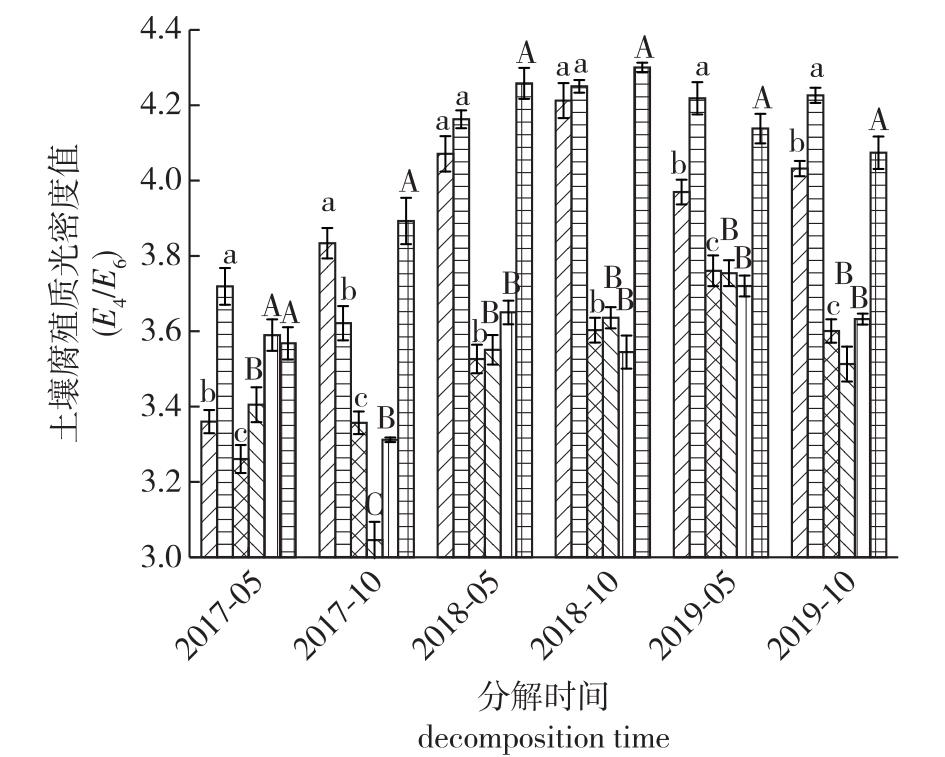【目的】研究五大连池火山熔岩孤丘特殊生境中针叶林和阔叶林不同种类凋落叶下土壤腐殖化程度的差异,分析凋落叶分解过程中主场(原来的森林生境)优势对土壤腐殖化的影响,为探究五大连池火山地区不同森林生境土壤成土过程和养分积累提供理论依据。【方法】2016年9月下旬在五大连池火山熔岩孤丘针叶林与阔叶林中分别设置3个分解样地,采集山杨(Populus davidiana)、白桦(Betula platyphylla)和落叶松(Larix gmelinii)3种优势树种当年凋落叶,分别在凋落叶分解袋中装入10 g单一凋落叶,进行凋落叶互换实验(即每个分解样地同时放置3种凋落叶分解袋),于2017—2019每年5和10月的15日,分别从分解样地中取回凋落物分解袋的正下方0~10 cm土壤,对土壤腐殖质进行光学性能指标检测,以此来探究土壤腐殖化程度对凋落叶在主客场分解的响应差异。【结果】①凋落叶在客场分解改变了土壤腐殖质的光密度(E4/E6)、色调系数(ΔlogK)和相对色度(RF)值的变化趋势。②白桦与山杨凋落叶下土壤腐殖质E4/E6和ΔlogK值主场均高于客场,RF值主场低于客场,落叶松凋落叶下土壤腐殖质E4/E6、ΔlogK和RF值主场均低于客场。③分解时间和森林类型均对土壤腐殖质的E4/E6、ΔlogK和RF值有显著影响,凋落叶种类对RF值无显著影响,对E4/E6和ΔlogK值有显著影响,时间-森林类型、时间-凋落叶种类及时间-森林类型-凋落叶种类交互作用显著。【结论】阔叶凋落叶和针叶凋落叶分解均表现为针叶林土壤腐殖化程度高于阔叶林土壤,针叶植物凋落叶分解对土壤腐殖化产生“主场优势”影响,而阔叶植物凋落叶分解对土壤腐殖化无明显“主场优势”影响。
【Objective】The study aimed to investigate the differences in the degree of soil humification in the presence of foliar litter from different plant species in coniferous and broad-leaved forests in the special habitat of Wudalianchi volcanic kipuka, analyze the influence of soil humification in the home-field advantage during the decomposition of foliar litter, and provide a theoretical basis for exploring the process of soil formation and nutrient accumulation in different habitats in the volcanic forest of Wudalianchi. 【Method】Three decomposition plots were separately established in the coniferous and broad-leaved forests of Wudalianchi volcanic kipuka in late September 2016. The fresh leaves of three dominant trees, namely, Populus davidiana, Betula platyphylla and Larix gmelinii, were collected from the coniferous and broad-leaved forests. Then 10 g of the foliar litter was transferred to separate foliar litter decomposition bags. The litter decomposition interactive transfer experiment was established by transferring three foliar litter decomposition bags in separate litter plots at the same time. Then 0-10 cm of the soil directly underneath the foliar litter decomposition bags was retrieved from the decomposition plots from 2017 to 2019, around the 15th of May and October each year. The optical performance indices of the soil humus substances were detected, and the optical characteristics of the soil humus substances under different foliar litter were analyzed. The differences in the degree of soil humification following foliar litter decomposition in the home and away fields were also analyzed. 【Result】The decomposition of foliar litter in the away field altered the soil optical density (E4/E6), hue coefficient (ΔlogK), and relative chromaticity (RF) values of the humus substances during the 3-year decomposition period. The E4/E6 and ΔlogK values of the soil humification substances under the foliar litter of P. davidiana and B. platyphylla were higher in the home field than in the away field. However, the RF values of the soil humification substances were lower in the home field than in the away field, and the E4/E6, ΔlogK, and RF values under the foliar litter of L. gmelinii were lower in the home field than in the away field. The duration of decomposition and forest type had a significant effect on the E4/E6, ΔlogK, and RF values of the soil humification substances. Although the foliar litter species had no significant effect on the RF values, they significantly affected the values of E4/E6 and ΔlogK. The time-forest type, time-litter species, and time-forest type-litter species interactions were found to be significant.【Conclusion】Analysis of the decomposition of the foliar litter of broad-leaved and coniferous forests revealed that the degree of soil humification in the coniferous forest was higher than that in the broad-leaved forest. The decomposition of foliar litter in the coniferous forest exerted a “home-field advantage” on soil humification, which was not observed in the broad-leaved forest.
 PDF(1621 KB)
PDF(1621 KB)


 PDF(1621 KB)
PDF(1621 KB)
 PDF(1621 KB)
PDF(1621 KB)
